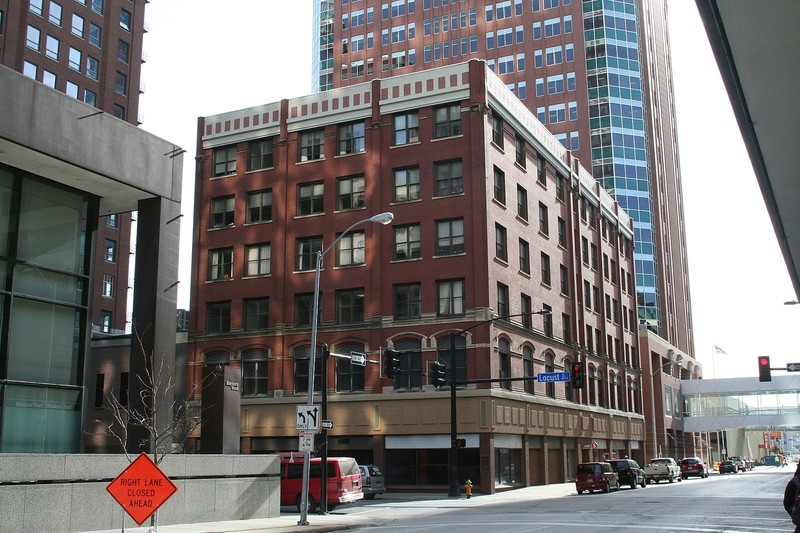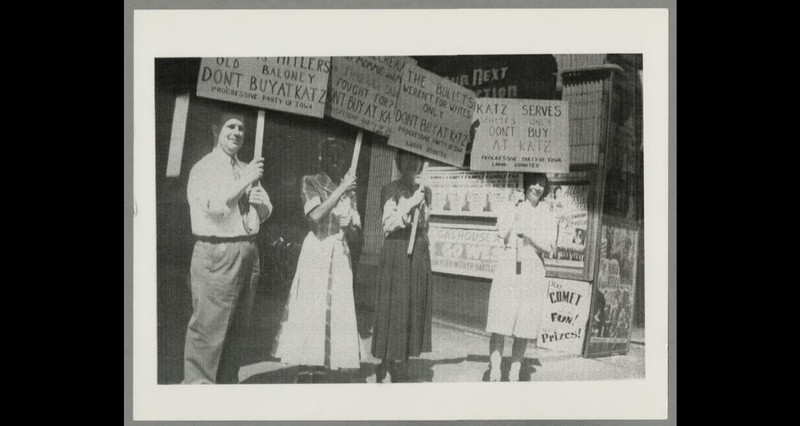Flynn-Griffin Building and 1948 Civil Rights Protest at Katz Department Store
Introduction
Text-to-speech Audio
Images
2016 Photo of the Flynn-Griffin Building in Des Moines.

Civil Rights protesters outside of Katz Department Story

Undated photo of Edna Griffin
.jpg)
Backstory and Context
Text-to-speech Audio
The Flynn–Griffin Building also goes by many other names, including the Flynn Block, Peoples' Savings Bank Building, and the Edna M. Griffin Building. The building enjoys significance for its long connection to commerce in Des Moines and its association with a significant Civil Rights event in 1948. Edna Griffin, an outspoken African American woman, and her friends, definitely entered the whites-only Katz Drug Store on the building's first floor to buy ice cream and sodas.
The erection of the structure occurred in two stages, with the first three floors finished by 1885 and the top three floors completed in 1906. The first portion of the Flynn-Griffin building name is tied to Martin Flynn, a successful entrepreneur who gained wealth in the cattle and railroad industries before getting into banking. He worked as part of a group that created Peoples' Savings Bank, and its success led to the creation of the historic six-story building. The bank occupied the northwest corner of the building through 1905 when its success, coupled with the city's growth and prosperity resulted in the expansion and remodeling of the building in 1906. The Peoples' Savings Bank assumed a much larger space in the newly renovated building, and the exterior and interior spaces were modified to reflect the bank's rising status.
The "Flynn Block" as it was known during the nineteenth century because of its city-block-sized width stood at the edge of the quickly growing commercial district of Des Moines. Stores that occupied the first floor included dry goods and clothing stores, as well as several department stores. Des Moines also served as an influential marketplace for the insurance industry by the heart of the Industrial Revolution. Numerous insurance companies maintained offices on the upper floors, such as Prudential, Aetna, National Life Insurance Co., Mutual Fire Insurance Co., and Equitable Life Insurance Co.
In 1930, after the bank departed, the Katz Drug Store moved into the first floor, and it would later serve as the home to one of the states, if not the nation's most notorious civil rights movement incidents. Despite laws against racial segregation in Iowa, it existed in practice. In 1948 Edna Griffin, with her infant daughter Phyllis, John Bibbs, and Leonard Hudson sat at the whites-only lunch counter at Katz's and ordered ice cream. The store refused to serve them, stating that they were "not equipped" to serve Negros. The authorities charged Katz of violating the state's civil rights law. The store appealed their conviction but the Iowa Supreme Court upheld the decision in 1949. The decision was significant as other businesses in Des Moines ended their sometimes unstated policy of only serving white customers in response.
Griffen continued to be an activist into her senior years as demonstrated by her arrest at an army base near Omaha, Nebraska, where, as a 75-year old grandmother, Griffin sat in the middle of the highway to stop nuclear warheads from being shipped to the base. Among her many awards and honors, Griffin was inducted into the Iowa Women's Hall of Fame in 1985 and into the Iowa African Americans' Hall of Fame in 1998, honors representative of her significance in the history of Iowa.
Sources
Brigham, Johnson. Des Moines: The Pioneer of Municipal Progress And Reform of the Middle West, Together With the History of Polk County, Iowa, the Largest, Most Populous And Most Prosperous County In the State of Iowa. Chicago: The S. J. Clarke publishing company, 1911.
Lawrence, Noah. “Since it is my right, I would like to have it: Edna Griffin and the Katz Drug Store Desegregation Movement.” The Annals of Iowa, Third Series, Vol. 67, No. 4, Fall 2008.
McDowell, Alexa. "Nomination Form: Flynn Building." National Register of Historic Places. nps.gov. May 3, 2016. https://www.nps.gov/nr/feature/places/pdfs/16000215.pdf
By Alexa McDowell - Own work, CC BY-SA 4.0, https://commons.wikimedia.org/w/index.php?curid=53282955
Iowa Women's Archives at the University of Iowa Librarie
Iowa Women's Archives at the University of Iowa Librarie
